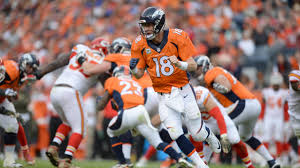Peyton Manning, the quarterback for the Denver Broncos, has been suffering with plantar fasciitis for several weeks as was revealed when his condition progressed to a partial tear during a recent game. In many cases, a partial tear may result in more pain than a full tear. Manning was sidelined during the game against Kansas City after sustaining this injury. His brother Eli Manning, the quarterback for the New York Giants, has sustained a similar injury before, with a total tear of the fascia back in 2009.
Plantar fasciitis is a common condition often seen with overuse and stress on the foot. The fascia is a tough band of connective tissue that attaches from the heel bone to the base of the toes. The fascia is one of the key players in creating tension in the shock-absorbing arch of your foot. Microtears are thought to contribute to pain in athletes and runners and are believed to be a result of significant inflammation. Abrupt force on top of this chronic underlying injury may occasionally cause the fascia to rupture. Sometimes, cortisone injections treating the inflammation caused by fasciitis can also induce a tear because it can weaken the connective tissue that holds the fasciae together.
Many cases follow steroid injections that can help with plantar fascia pain. A tear usually requires an abrupt dynamic force that is followed by acute pain. It may be seen in athletes, but it can also appear in people suffering from chronic plantar fasciitis. Other conditions that require steroid medications or fluoroquinolone and antibiotics like levofloxacin or ciprofloxacin may also precipitate a tear. Although both Manning brothers sustained tears of the fascia, it is still considered a relatively uncommon condition. Some of the signs of a torn fascia include:
- Intense pain in the heel or arch while walking or at rest
- A painful lump in the arch of the foot or heel with swelling or bruising
- Hearing or feeling a pop or tearing in the foot
- The collapsing of the arch
- Pain when toes are bent upward
Treatment for a plantar fascia tear or rupture is typically nonoperative. Since it can be accompanied by excruciating pain, you should see a podiatrist right away. A common treatment plan includes rest and immobilization in a walking boot or cast followed by slow stretching over the course of a few weeks. Platelet-rich-plasma (PRP) injections, an experimental treatment, may be considered in certain cases as determined by your doctor to help with healing. This is an injection of some of your body’s own blood plasma injected back into the injury site. Healing time from fascial tears can vary from several weeks to months; for example, the NBA’s Pau Gasol was out for six weeks after a plantar fascial injury. We wish Manning a speedy and full recovery!

